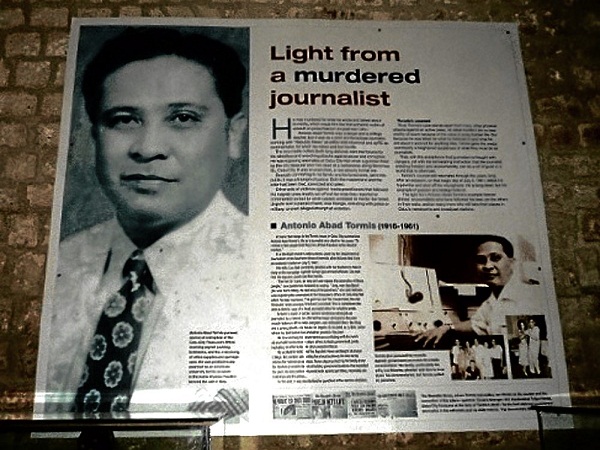
ANTONIO Abad Tormis, an editor and columnist of the now defunct The Republic News, is Cebu’s first postwar martyr of press freedom. Photo by Charisse Ursal
CEBU CITY—A visit to a museum has convinced Jessa Parreño to pursue a career in broadcast journalism once she completes a mass communication degree at the University of the Philippines College Cebu.
A sophomore, Parreño says she wants to see herself in the photos displayed on the wallboards at Cebu Journalism and Journalists (CJJ) Gallery inside Museo Sugbo, the biggest museum of the provincial government, on M.J. Cuenco Avenue in Cebu City.
“The gallery made me realize that Cebu has great journalists who are willing to fight for fairness and truth, and this encourages me to do well in school so that by the time I graduate, I’ll be like them,” she says.
The CJJ display, the first of its kind in the country, is among the 13 galleries at Museo Sugbo, also called Cebu Provincial Museum. Aside from the photos, it exhibits the equipment used by journalists, both from the prewar and postwar eras —from old cameras to printing equipment and old journalism books and newspapers.
THE CLASSIC Linotype machine, a printing machine used by newspapers before the 1970s, is prominently displayed outside of Cebu Journalism and Journalists Gallery inside Museo Sugbo in Cebu City. Photo by Charisse Ursal
It was put up in 2010 by the Cebu Citizens-Press Council (CCPC), a nonstock, nonprofit organization which aims to defend press freedom, promote media professionalism, and help shape public opinion on media issues.
Former prison facility
Museo Sugbo is housed at a former prison facility built in 1871 during the Spanish colonial rule. It is formerly called Carcel de Cebu and Carcel de Visayas, and later, Cebu Provincial Detention and Rehabilitation Center (CPDRC).
The building was occupied by the Department of Education for eight months after CPDRC moved out to a bigger facility in Barangay Kalunasan, also in Cebu City, in 2004. Incumbent Gov. Gwendolyn Garcia decided to use the structure as a repository of Cebuano culture and heritage.
“We Cebuanos don’t exactly know what really happened in the past and the museum, through the collection of rare artifacts from various excavations, gives the people a better grasp of our history,” says Rex Fernandez, one of the curators.
Museo Sugbo contains artifacts and items dating back to the pre-Spanish era. Some of its galleries showcase memorabilia from prominent Cebuanos, like Sen. Vicente Rama and Justice Sotero Cabahug.
Fernandez says CJJ Gallery shows the dynamism of media in Cebu and how Cebuano journalists fought for freedom, even before martial law was declared by the late strongman Ferdinand Marcos in 1972.
“Although it (CJJ Gallery) is still young and developing, it can be a testament of how media in Cebu flourished,” he says.
Wallboards
Photos of journalists before and after World War II are shown on the wallboards and picture frames at CJJ Gallery. One wallboard belongs to Antonio Abad Tormis, Cebu’s first postwar martyr of press freedom.
A REPLICA of a radio booth is one of the attractions at Cebu Journalism and Journalists Gallery inside Museo Sugbo in Cebu City. CONTRIBUTED PHOTO
According to The Freedom Forum Journalists Memorial, Tormis, an editor-columnist of the now defunct The Republic News, was shot on July 3, 1961, along Borromeo Street by the then city treasurer for exposing financial irregularities at City Hall.
What stands out in an alley leading to CJJ Gallery is the classic typesetting machine called Linotype Machine Model 31.
The machine, measuring 56 inches wide, 67 inches long and 84 inches high, was commercially introduced in the United States in 1886 and used by newspapers in Cebu before 1970, according to the CCPC.
Another attraction is a replica of a radio booth, which displays a 1960s-era Crown Model STP-50 radio stereo phonograph. The booth also features the logos of contemporary AM radio stations involved in news and public affairs programming, as well as old photos of past broadcasters.
Press Freedom Week
As one of the celebration highlights during the Cebu Press Freedom Week on Sept. 16-22, a guided tour, dubbed “Heritage Visit,” will be conducted for students and media workers at CJJ Gallery on Sept. 17.
Now on the 18th year, the Cebu Press Freedom Week falls every third week of September to coincide with the anniversary of the declaration of martial law on Sept. 21, 1972. The activity is unique to Cebu.
“The celebration aims to raise awareness among the public on the need to protect press freedom. Without press freedom, the other freedoms we enjoy as a democracy will also be lost,” said Cherry Ann Lim, assistant executive director of the CCPC.
Seeing the wallboards, Parreño says, has encouraged her to vigorously pursue a career in journalism. “Efforts of the media people who sacrificed their lives to fight for what is right and expose the truth to the people will be put to waste if I don’t become one of them,” she says.